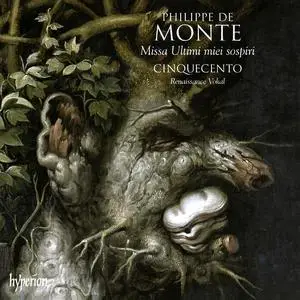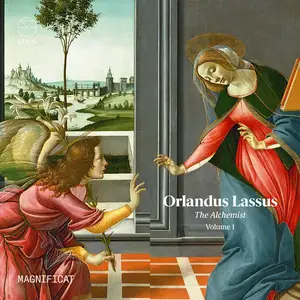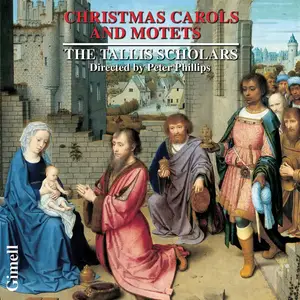Verdelot, Philippe
Cinquecento - Philippe de Monte: Missa Ultimi miei sospiri & other sacred music (2008) Music
Posted by ArlegZ at Sept. 8, 2023
Cinquecento - Philippe de Monte: Missa Ultimi miei sospiri & other sacred music (2008)
EAC | FLAC | Image (Cue & Log) ~ 263 Mb | Total time: 56:12 | Scans included
Classical | Label: Hyperion | # CDA67658 | Recorded: 2007
EAC | FLAC | Image (Cue & Log) ~ 263 Mb | Total time: 56:12 | Scans included
Classical | Label: Hyperion | # CDA67658 | Recorded: 2007
In their third disc for Hyperion, the acclaimed vocal ensemble Cinquecento continue their exploration of the rich repertoire engendered in the Habsburg court. The prolific composer De Monte, Kapellmeister to the Emperor Maximilian II, wrote over a thousand madrigals as well as hundreds of sacred works, and the expressive aspects of the madrigal infuse his sacred music delightfully. His Missa Ultimi miei sospiri contains the constant interplay between groups of voices and dramatic word-setting which are features of the madrigal genre. The motets recorded here cover many Biblical and liturgical subjects and demonstrate the wide range of techniques and styles used by the composer.
Doulce Mémoire & Denis Raisin-Dadre - Verdelot: Madrigali diminuiti (Diminutions inspirées de Sylvestro Ganassi) (2016) [24/88] Vinyl & HR
Posted by SERTiL at July 2, 2017
Doulce Mémoire & Denis Raisin-Dadre - Verdelot: Madrigali diminuiti (Diminutions inspirées de Sylvestro Ganassi) (2016)
FLAC (tracks) 24-bit/88.2 kHz | Time - 67:14 minutes | 1.06 GB
Studio Master, Official Digital Download | Artwork: Digital booklet
FLAC (tracks) 24-bit/88.2 kHz | Time - 67:14 minutes | 1.06 GB
Studio Master, Official Digital Download | Artwork: Digital booklet
In 1535 Sylvestro Ganassi published in Venice the first treatise developing the technique of the art of ornamentation at an unprecedented level of rhythmic complexity and virtuosity. Playing the recorder, the instrument to which Ganassi devoted his work, Denis Raisin Dadre applies the rules of the treatise to the repertoire that Ganassi practiced, frottole and, above all, the madrigals of Philippe Verdelot. With the ornaments, the music proves to be a living art that practices a constant rhythmic shift, the exuberant virtuosity of improvisations and a ‘swing’ that would be typical of jazz in the 20th century.
Jérôme Lejeune - L'Europe Musicale de la Renaissance / Music in Europe at the Time of the Renaissance [8CDs] (2013) Music
Posted by ArlegZ at Jan. 30, 2022
Jérôme Lejeune - L'Europe Musicale de la Renaissance / Music in Europe at the Time of the Renaissance [8CDs] (2013)
EAC | FLAC | Image (Cue & Log) ~ 2.88 Gb | Total time: 10h35' | Scans included
Classical | Label: Ricercar | # RIC 106
EAC | FLAC | Image (Cue & Log) ~ 2.88 Gb | Total time: 10h35' | Scans included
Classical | Label: Ricercar | # RIC 106
Jérôme Lejeune continues his History of Music series with this boxed set devoted to the Renaissance. The next volume in the series after Flemish Polyphony (RIC 102), this set explores the music of the 16th century from Josquin Desprez to Roland de Lassus. After all of the various turnings that music took during the Middle Ages, the music of the Renaissance seems to be a first step towards a common European musical style. Josquin Desprez’s example was followed by every composer in every part of Europe and in every musical genre, including the Mass setting, the motet and all of the various new types of solo song. Instrumental music was also to develop considerably from the beginning of the 16th century onwards.
New York Polyphony - Sing Thee Nowell (2014) [Official Digital Download 24/96] Vinyl & HR
Posted by SERTiL at May 15, 2017
New York Polyphony - Sing Thee Nowell (2014)
FLAC (tracks) 24-bit/96 kHz | Time - 71:05 minutes | 1.27 GB
Studio Master, Official Digital Download | Artwork: Digital booklet
FLAC (tracks) 24-bit/96 kHz | Time - 71:05 minutes | 1.27 GB
Studio Master, Official Digital Download | Artwork: Digital booklet
Nowell, Nowel, Noel - on their new release, Sing thee Nowell, New York Polyphony sings of, and to, the birth of Christ in a typically sophisticated programme which fuses the ancient with the modern into a seamless whole. Seven centuries of Christmas passes before the listener with new works composed for these performers by Michael McGlynn, Andrew Smith and John Scott alongside traditional medieval and Renaissance carols and motets by Clemens 'non Papa', Philippe Verdelot and Tomás Luis de Victoria.
Philip Cave, Magnificat - Orlandus Lassus: The Alchemist, Volume 1 (2024) Music
Posted by ArlegZ at July 18, 2024
Philip Cave, Magnificat - Orlandus Lassus: The Alchemist, Volume 1 (2024)
EAC | FLAC | Image (Cue & Log) ~ 657 Mb | Total time: 02:37:30 | Scans included
Classical | Label: Linn Records | # CKD 660 | Recorded: 2023
EAC | FLAC | Image (Cue & Log) ~ 657 Mb | Total time: 02:37:30 | Scans included
Classical | Label: Linn Records | # CKD 660 | Recorded: 2023
Under the direction of Philip Cave, Magnificat embarks on a three-volume journey exploring the ingenuity of Orlandus Lassus. In this rich collection of Magnificats based on polyphonic models, Lassus – ‘The Alchemist’ – demonstrates an unsurpassed ability to reimagine existing material in the creation of his own works. This first volume of the series presents Lassus’s Magnificats based on madrigals, featuring models by Philippe Verdelot, Cipriano de Rore, and Alessandro Striggio among others. The second album will comprise Lassus’s canticles based on motets, and the third will conclude with those inspired by chansons. In celebrating Lassus as ‘The Alchemist’, Magnificat reveals the creative process and skill he employed in re-working the original music and illuminates a significant repertory that is underrepresented in contemporary liturgical or concert settings.
Philip Cave, Magnificat - Orlandus Lassus: The Alchemist, Volume 1 (2024) Music
Posted by ArlegZ at July 18, 2024
Philip Cave, Magnificat - Orlandus Lassus: The Alchemist, Volume 1 (2024)
EAC | FLAC | Image (Cue & Log) ~ 657 Mb | Total time: 02:37:30 | Scans included
Classical | Label: Linn Records | # CKD 660 | Recorded: 2023
EAC | FLAC | Image (Cue & Log) ~ 657 Mb | Total time: 02:37:30 | Scans included
Classical | Label: Linn Records | # CKD 660 | Recorded: 2023
Under the direction of Philip Cave, Magnificat embarks on a three-volume journey exploring the ingenuity of Orlandus Lassus. In this rich collection of Magnificats based on polyphonic models, Lassus – ‘The Alchemist’ – demonstrates an unsurpassed ability to reimagine existing material in the creation of his own works. This first volume of the series presents Lassus’s Magnificats based on madrigals, featuring models by Philippe Verdelot, Cipriano de Rore, and Alessandro Striggio among others. The second album will comprise Lassus’s canticles based on motets, and the third will conclude with those inspired by chansons. In celebrating Lassus as ‘The Alchemist’, Magnificat reveals the creative process and skill he employed in re-working the original music and illuminates a significant repertory that is underrepresented in contemporary liturgical or concert settings.
Claudio Astronio - Cabezon: Obras de Musica. Complete Edition (7CDs, 2012) Music
Posted by murena at Nov. 5, 2018
Claudio Astronio - Cabezon: Obras de Musica. Complete Edition (7CDs, 2012)
EAC Rip | FLAC (Image+.cue, log) | 7 CDs, 07:34:45 min | 2,17 Gb | Scans ->8 mb
Genre: Classical / Label: Brilliant Classics
EAC Rip | FLAC (Image+.cue, log) | 7 CDs, 07:34:45 min | 2,17 Gb | Scans ->8 mb
Genre: Classical / Label: Brilliant Classics
As court organist to Queen Isabella as well as the music teacher of her children with Charles V Antonio de Cabezon was perfectly placed to become the most important composer of the Spanish Golden Age of the 16th century. This complete recorded survey celebrates his remarkable body of work as well as his unique style and mastery.
Magnificat & Philip Cave - Lassus: The Alchemist (Vol. 1) (2024) [Official Digital Download 24/96] Vinyl & HR
Posted by delpotro at Feb. 20, 2024
Magnificat & Philip Cave - Lassus: The Alchemist (Vol. 1) (2024)
FLAC (tracks) 24-bit/96 kHz | Front Cover & Digital Booklet | Time - 157:25 minutes | 2,98 GB
Classical, Sacred, Choral | Label: Linn Records, Official Digital Download
FLAC (tracks) 24-bit/96 kHz | Front Cover & Digital Booklet | Time - 157:25 minutes | 2,98 GB
Classical, Sacred, Choral | Label: Linn Records, Official Digital Download
Under the direction of Philip Cave, Magnificat embarks on a three-volume journey exploring the ingenuity of Orlandus Lassus. In this rich collection of Magnificats based on polyphonic models, Lassus - 'The Alchemist' - demonstrates an unsurpassed ability to reimagine existing material in the creation of his own works. This first volume of the series presents Lassus's Magnificats based on madrigals, featuring models by Philippe Verdelot, Cipriano de Rore, and Alessandro Striggio among others. The second album will comprise Lassus's canticles based on motets, and the third will conclude with those inspired by chansons. In celebrating Lassus as 'The Alchemist', Magnificat reveals the creative process and skill he employed in re-working the original music and illuminates a significant repertory that is underrepresented in contemporary liturgical or concert settings.
Magnificat & Philip Cave - Lassus: The Alchemist (Vol. 1) (2024) Music
Posted by delpotro at Feb. 20, 2024
Magnificat & Philip Cave - Lassus: The Alchemist (Vol. 1) (2024)
WEB FLAC (tracks) - 711 Mb | MP3 CBR 320 kbps - 364 Mb | Digital booklet | 02:37:25
Classical, Sacred, Choral | Label: Linn Records
WEB FLAC (tracks) - 711 Mb | MP3 CBR 320 kbps - 364 Mb | Digital booklet | 02:37:25
Classical, Sacred, Choral | Label: Linn Records
Under the direction of Philip Cave, Magnificat embarks on a three-volume journey exploring the ingenuity of Orlandus Lassus. In this rich collection of Magnificats based on polyphonic models, Lassus - 'The Alchemist' - demonstrates an unsurpassed ability to reimagine existing material in the creation of his own works. This first volume of the series presents Lassus's Magnificats based on madrigals, featuring models by Philippe Verdelot, Cipriano de Rore, and Alessandro Striggio among others. The second album will comprise Lassus's canticles based on motets, and the third will conclude with those inspired by chansons. In celebrating Lassus as 'The Alchemist', Magnificat reveals the creative process and skill he employed in re-working the original music and illuminates a significant repertory that is underrepresented in contemporary liturgical or concert settings.
Peter Phillips, The Tallis Scholars - Christmas Carols and Motets (1986) Music
Posted by ArlegZ at Dec. 8, 2024
Peter Phillips, The Tallis Scholars - Christmas Carols and Motets (1986)
EAC | FLAC | Image (Cue & Log) ~ 233 Mb | Total time: 56:57 | Scans included
Classical | Label: Gimell | # CDGIM010 | Recorded: 1986
EAC | FLAC | Image (Cue & Log) ~ 233 Mb | Total time: 56:57 | Scans included
Classical | Label: Gimell | # CDGIM010 | Recorded: 1986
This recording presents three traditional ways of celebrating Christmas in music – medieval carols, Renaissance motets praising the Virgin Mary, and German chorales. The medieval pieces are sung in their original forms, without modern ‘arrangement’. All those performed here are of English provenance, and culminate in three versions of the Coventry Carol, which include Byrd’s famous Lullaby.

![Doulce Mémoire & Denis Raisin-Dadre - Verdelot: Madrigali diminuiti (Diminutions inspirées de Sylvestro Ganassi) (2016) [24/88]](https://pixhost.icu/avaxhome/9e/d3/0046d39e_medium.jpg)
![Jérôme Lejeune - L'Europe Musicale de la Renaissance / Music in Europe at the Time of the Renaissance [8CDs] (2013)](https://pixhost.icu/avaxhome/5c/48/008c485c_medium.jpg)
![New York Polyphony - Sing Thee Nowell (2014) [Official Digital Download 24/96]](https://pixhost.icu/avaxhome/3c/a9/0045a93c_medium.jpg)


![Magnificat & Philip Cave - Lassus: The Alchemist (Vol. 1) (2024) [Official Digital Download 24/96]](https://pixhost.icu/avaxhome/9f/39/00a9399f_medium.jpg)
